RESEARCH
Narrowing socioeconomic inequality in child stunting: the Brazilian experience, 19742007
Réduction des inégalités socioéconomiques en termes de retard de croissance des enfants : expérience du Brésil, 1974-2007
Reducción de la desigualdad socioeconómica en materia de retraso del crecimiento infantil: la experiencia del Brasil, 19742007
Carlos Augusto MonteiroI,*; Maria Helena D'Aquino BenicioI; Wolney Lisboa CondeI; Silvia KonnoI; Ana Lucia LovadinoI; Aluisio JD BarrosII; Cesar Gomes VictoraII
ISchool of Public Health, University of São Paulo, Av. Dr Arnaldo 715, São Paulo, 01246-904, SP, Brazil
IIPost-Graduate Program in Epidemiology, Federal University of Pelotas, Pelotas, Brazil
ABSTRACT
OBJECTIVE: To assess trends in the prevalence and social distribution of child stunting in Brazil to evaluate the effect of income and basic service redistribution policies implemented in that country in the recent past.
METHODS: The prevalence of stunting (height-for-age z score below −2 using the Child Growth Standards of the World Health Organization) among children aged less than 5 years was estimated from data collected during national household surveys carried out in Brazil in 197475 (n = 34 409), 1989 (n = 7374), 1996 (n = 4149) and 200607 (n = 4414). Absolute and relative socioeconomic inequality in stunting was measured by means of the slope index and the concentration index of inequality, respectively.
FINDINGS: Over a 33-year period, we documented a steady decline in the national prevalence of stunting from 37.1% to 7.1%. Prevalence dropped from 59.0% to 11.2% in the poorest quintile and from 12.1% to 3.3% among the wealthiest quintile. The decline was particularly steep in the last 10 years of the period (1996 to 2007), when the gaps between poor and wealthy families with children under 5 were also reduced in terms of purchasing power; access to education, health care and water and sanitation services; and reproductive health indicators.
CONCLUSION: In Brazil, socioeconomic development coupled with equity-oriented public policies have been accompanied by marked improvements in living conditions and a substantial decline in child undernutrition, as well as a reduction of the gap in nutritional status between children in the highest and lowest socioeconomic quintiles. Future studies will show whether these gains will be maintained under the current global economic crisis.
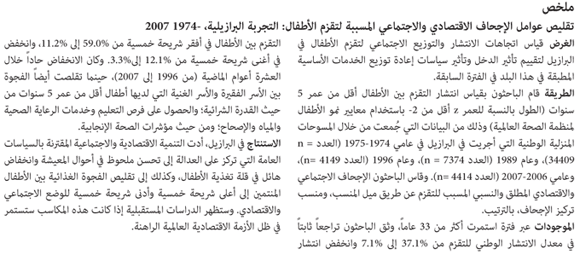
RÉSUMÉ
OBJECTIF: Estimer les tendances de la prévalence et de la répartition sociale du retard de croissance chez l'enfant au Brésil afin d'évaluer les effets des politiques de redistribution des revenus et des services de base mises en œuvre dans ce pays au cours des dernières années.
MÉTHODES: La prévalence du retard de croissance (z-score de la taille en fonction de l'âge < -2 si l'on utilise les Normes OMS de croissance de l'enfant) parmi les enfants de moins de 5 ans a été estimée à partir des données recueillies dans le cadre d'enquêtes nationales auprès des ménages menées au Brésil en 1974-1975 (n = 34 409), en 1989 (n = 7374), en 1996 (n = 4149) et en 2006-2007 (n = 4414). Les inégalités socioéconomiques relatives et absolues en matière de retard de croissance ont été mesurées respectivement par l'indice de pente et par l'indice de concentration des inégalités.
RÉSULTATS: Sur une période de 33 ans, nous avons enregistré une baisse régulière de la prévalence nationale du retard de croissance de 37,1 à 7,1 %. La prévalence a chuté de 59,0 à 11,2 % dans le quintile le plus pauvre et de 12,1 à 3,3 % dans le quintile le plus riche. Cette baisse a été particulièrement forte au cours des 10 dernières années de la période (1996 à 2007), pendant que l'écart entre familles pauvres et aisées comprenant des enfants de moins de 5 ans se réduisait aussi en termes de pouvoir d'achat, d'accès à l'éducation, aux soins de santé, à l'eau et aux services d'assainissement et de valeurs des indicateurs de santé génésique.
CONCLUSION: Au Brésil, le développement socioéconomique, couplé à des politiques en faveur de l'équité, s'est accompagné d'améliorations marquées des conditions de vie, d'une baisse substantielle de la dénutrition de l'enfant et d'une réduction de l'écart de statut nutritionnel entre les quintiles les plus riches et les plus pauvres. D'autres études permettront de déterminer si ces gains se maintiennent dans le cadre de la crise économique mondiale actuelle.
RESUMEN
OBJETIVO: Evaluar las tendencias de la prevalencia y la distribución social del retraso del crecimiento infantil en el Brasil a fin de evaluar el efecto de las políticas de redistribución de los ingresos y los servicios básicos aplicadas en ese país en los últimos años.
MÉTODOS: Se estimó la prevalencia de retraso del crecimiento (puntuación z de la talla para la edad inferior a 2 empleando los patrones de crecimiento infantil de la Organización Mundial de la Salud) entre los menores de 5 años a partir de datos recogidos en encuestas nacionales de hogares realizadas en el Brasil en 197475 (n = 34 409), 1989 (n = 7374), 1996 (n = 4149) y 200607 (n = 4414). La desigualdad socioeconómica absoluta y relativa en materia de retraso del crecimiento se determinó midiendo el índice de desigualdad de la pendiente y el índice de concentración, respectivamente.
RESULTADOS: A lo largo de 33 años, hemos documentado una disminución constante de la prevalencia nacional de retraso del crecimiento del 37,1% al 7,1%. La prevalencia se redujo del 59,0% al 11,2% en el quintil más pobre, y del 12,1% al 3,3% en el quintil más rico. La disminución fue especialmente pronunciada en los últimos 10 años considerados (1996-2007), periodo durante el cual la brecha entre las familias pobres y ricas con menores de 5 años también se redujo en términos de poder adquisitivo; acceso a la educación, la atención sanitaria y los servicios de abastecimiento de agua y saneamiento; e indicadores de salud reproductiva.
CONCLUSIÓN: En el Brasil, el desarrollo socioeconómico unido a políticas públicas favorables a la equidad ha ido acompañado de mejoras notables de las condiciones de vida y de una disminución considerable de la desnutrición infantil, así como de una reducción de la brecha observada en lo tocante al estado nutricional entre los niños de los quintiles socioeconómicos superior e inferior. Los nuevos estudios que se hagan en el futuro nos indicarán si esos beneficios se han mantenido o no durante la actual crisis económica mundial.
Introduction
Optimal child growth requires adequate energy and nutrient intake, absence of disease and appropriate care. Poor living conditions, including household food insecurity, low parental education, lack of access to quality health care and an unhealthy living environment are among the main determinants of stunted growth. Poverty has a more detrimental effect on linear growth than on body weight.1 Child stunting is associated with higher morbidity and mortality, shorter height in adulthood, lower educational achievement, and reduced productivity in adulthood. Child growth patterns are therefore strong predictors of future human capital and social progress and of the health of future generations.14
Estimates indicate that in 2005, one-third of all children less than 5 years of age (or approximately 178 million children) in low- and middle-income countries were stunted.5 Projections of current trends to 2015 point to declines in the prevalence of both stunting6 and underweight5 among children, although such declines will still fall short of the 50% reduction in undernutrition established as an indicator for fulfilling the first Millennium Development Goal (MDG-1),7 to eradicate hunger. Of 70 low- or middle-income countries that conducted two or more surveys between 1971 and 1999, 42 showed a decline in child stunting, 17 showed no major change over the period, and 11 (9 of them in Africa) showed an increase.8 In Brazil, three national health and nutrition surveys conducted between 197475 and 1996 have pointed to declining trends in child stunting prevalence.9,10
An analysis of data from 47 low- and middle-income countries showed pronounced within-country socioeconomic inequalities in child stunting, particularly in Latin America and the Caribbean.11 Brazil ranked fifth among these 47 countries in terms of such inequality.11 We are unaware of studies from low- or middle-income countries on how social inequalities in child stunting are evolving over time.
We have taken advantage of a Demographic and Health Survey carried out in Brazil in 200607 to assess trends in child stunting and in related socioeconomic disparities over the past three decades. The Brazilian government has prioritized the elimination of hunger and poverty12 since 2003, and recent reports13 suggest that redistributive policies have successfully redressed one of the most skewed income distributions in the world.14 Because child stunting is a sensitive indicator of living conditions, we believe that the effectiveness of redistributive policies can be accurately assessed by studying the social distribution of child stunting over time.
Methods
Data sources
Four national household surveys were carried out in Brazil over a period of 33 years: Estudo Nacional de Despesa Familiar [National Study on Family Expenditures] in 197475; Pesquisa Nacional de Saúde e Nutrição [National Health and Nutrition Survey] in 1989; and two Demographic and Health Surveys, in 1996 and 200607, respectively. Nationwide probability household samples were obtained in each survey using similar census-based, multistage, stratified, cluster sampling procedures. The sampling schemes, variables, and data collection procedures are described elsewhere. 1517
In the four surveys, the height of all children aged 059 months living in the sampled households was measured. Children living in the sparsely populated rural areas of the Northern region, who comprise 3% of the country's child population, were only included in the most recent survey. Analyses were repeated after removing these children from the 200607 sample, but the results were virtually identical to those presented below, which apply to the entire sample of children studied in each survey.
In the four surveys, trained personnel measured the recumbent length of children aged up to 23 months and the standing height of older children. Birth dates were obtained from birth certificates or other official documents. The questionnaires used in 197475, 1989 and 200607 but not in 1996 assessed family income directly by asking about all sources of household income over the prior month. The questionnaires used in 1996 and 200607 also assessed household characteristics, including the number and type of assets owned, parental schooling, water supply and sanitation services, maternal antenatal health care, and several reproductive health indicators, such as interval between births and maternal use of modern contraceptives.
Statistical analysis
We used the Child Growth Standards of the World Health Organization (WHO)18 to calculate length-for-age and height-for-age z scores (referred to henceforth as simply "height-for-age z scores"). We classified a child as stunted if his/her height-for-age z score was below −2.3 We calculated the prevalence of stunting and its 95% confidence interval (CI).
To assess trends in socioeconomic inequality we divided children into quintiles on the basis of household per capita income. In the 1996 survey, income was not measured directly, but on the basis of household assets and according to a predictive equation based on a 2005 economic survey which collected both assets and income.19 We created socioeconomic quintiles using both criteria from data for the 200607 sample, for which both income and household assets were available.
We used the slope index of inequality (SII) to quantify absolute socioeconomic disparities in child stunting. The SII, which is based on a weighted linear regression of the observed prevalence of stunting in the quintiles, expresses the absolute difference in outcome between the lowest and the highest quintiles.20 We defined the quintiles using sample weights and employed the absolute number of children in the quintiles as the frequency weights for the regression model. In the model, the dependent variable was the prevalence of stunting in each quintile.
We used two versions of the concentration index to measure inequality in child stunting: the original index21 and a modified index suggested by Erreygers.22 The concentration index measures relative inequality and its main advantage over using the ratio of the fifth to the first quintile is that it is based on data on all groups. The concentration index is similar to the Gini coefficient it ranges from −1 to +1 and a value of 0 indicates complete equality in the distribution of the outcome. Negative values indicate that the outcome is concentrated among the poor, and positive values indicate that it is concentrated among the rich. We calculated the corresponding indices and their CIs using the convenient regression approach recommended for cases in which microdata are available.21 We used both the SII and the concentration indices to describe trends.
To explore the underlying factors associated with recent changes in socioeconomic inequalities in child stunting, we examined quintile-specific changes from 1996 to 200607 in household assets, maternal education, and maternal antenatal health care, water supply and sanitation services, and reproductive health indicators. We tested these changes for statistical significance by fitting an interaction term between the year of the survey and the socioeconomic quintiles. These analyses were not undertaken for the 197475 and 1989 surveys due to the absence of a comparable set of variables. All analyses were carried out using the svy prefix commands of Stata version10 (Stata Corporation, College Station, TX, USA), which take into account the complex sample design used by each survey.
Ethics approval was not required for this study. The authors had full access to all the data in the study.
Results
The number of sampled households was 55 000 in 197475, 14 455 in 1989, 13 283 in 1996, and 13 056 in 200607. The corresponding number of children aged less than 5 years was 37 181, 7525, 4818 and 4820, respectively. Non-response rates for height were 6.2% in 197475, 1.8% in 1989, 13.2% in 1996, and 8.0% in 200607. Children with implausible height values (height-for-age z score below −6 or above +6) represented 1.3% of the sample in 197475 and less than 1% in the three other surveys. The final samples with valid values for height included 34 409 children in 197475, 7374 in 1989, 4149 in 1996 and 4414 in 200607.
Fig. 1 compares the height-for-age distribution of children in each of the four surveys with the distribution predicted by the WHO Child Growth Standards. A continuous shift towards normal growth among Brazilian children is seen over the three decades up to the most recent survey, conducted in 200607. The overall prevalence of stunting among children in the four surveys was as follows: 197475, 37.1% (95% CI: 34.639.6); 1989, 19.9% (95% CI: 17.821.9); 1996, 13.5% (95% CI: 12.114.8) and 200607, 7.1% (95% CI: 5.78.5). Thus, the overall prevalence of stunting in Brazilian children declined by more than 80% between 197475 and 200607, and its decline accelerated over time: 4.2% per year from 197475 to 1989; 5.4% from 1989 to 1996, and 6.0% from 1996 to 200607.
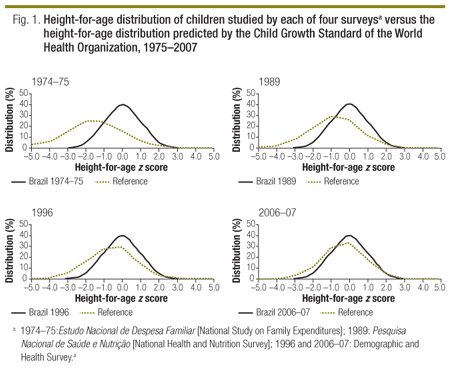
Table 1 shows the quintile-specific stunting prevalence derived from the four surveys on the basis of per capita income and/or the asset-based income proxy. For the last survey, quintile breakdowns are presented for both socioeconomic indicators, and the results shown are very similar. Absolute socioeconomic inequalities in child stunting, reflected by the slope index, declined over time, and the decline was sharper between 1996 and 200607. The two concentration indices show different trends. Erreygers's index suggests that relative socioeconomic inequalities in child stunting declined overtime and more sharply between 1996 and 200607, whereas the traditional concentration index indicates that they increased until 1996 and then declined sharply until 200607. The prevalence ratio comparing the poorest to the richest quintile, which equalled 4.9 in 197475, increased to 7.7 in 1989 and then declined to 6.3 in 1996 and to 2.6 in 200607. This impressive reduction of socioeconomic inequalities in the most recent period was paralleled by a reduction in the gap between the poorest and the richest quintiles in height-for-age distribution (Fig. 2).
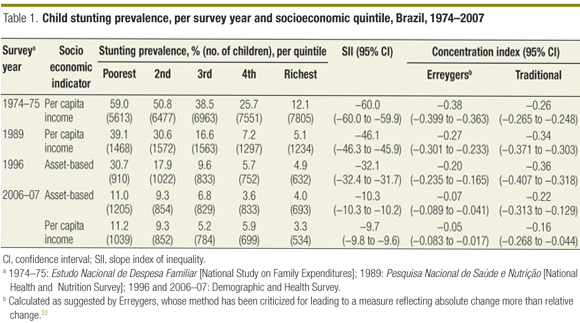
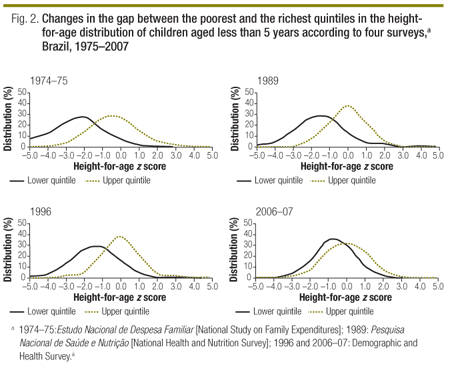
Recent changes (1996 to 200607) in socioeconomic inequalities for variables affecting child health and nutrition are consistent with a narrowing of disparities in stunting. Indicators of family purchasing power (Table 2), maternal education, access to health care (prenatal visits and use of modern contraceptives) and to water and sanitation services, and reproductive health indicators (birth order, birth intervals, and use of modern contraceptive methods) (Table 3) all improved steadily among all income groups, but particularly among the poorest.
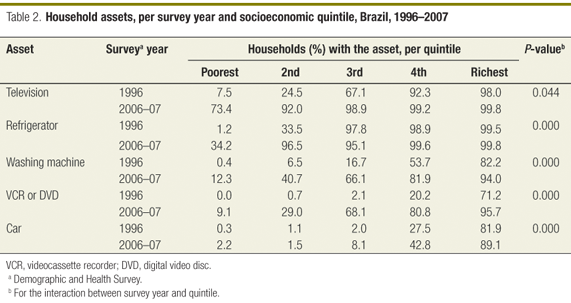
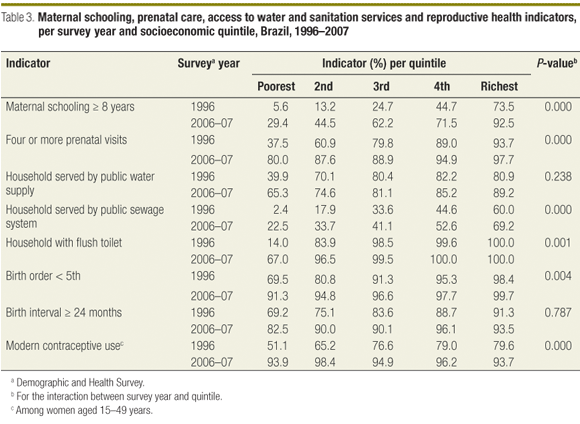
Discussion
By using data from four nationwide probability household surveys covering a 33-year period, we documented not only a steady decline in the prevalence of childhood stunting in Brazil, but also major reductions in the gap between poor and wealthy children. Both the overall decline and the reduction in socioeconomic inequalities in stunting were particularly sharp in the 10 years that transpired from 1996 to 200607, during which we also documented sharp reductions in the differences between poor and wealthy children for other socioeconomic indicators.
There is heated debate in the health economics literature about how best to measure trends in inequality.2224 The traditional concentration index is affected by the overall frequency of the outcome,25 which in our analyses changed markedly over time. Erreygers proposed a modified concentration index to avoid this pitfall,22 but his modification has been criticized for leading to a measure that reflects primarily absolute rather than relative inequalities.24 In the present analyses, trends in the traditional index mirrored trends in the ratio of stunting prevalence between the poorest and the wealthiest quintiles, whereas Erreygers's index varied in tandem with the absolute difference, estimated through the SII. All summary measures, however, showed a marked decline in inequality in the last period studied (1996 to 200607).
The MDG-1 calls for halving of the prevalence of child underweight between 1990 and 2015.7 The prevalence of underweight in Brazil fell from 5.6% in 1989 to 2.2% in 200607 (data not shown), or 61%. Thus, Brazil has already met the established goal. The corresponding reduction in the prevalence of stunting was 64%. Fortunately, there is no evidence that child overweight increased during the period: the proportions of children under 5 whose height-for-age is two or more z scores above the median according to the WHO standards were 8.4% in 1989, 6.6% in 1996 and 7.3% in 20062007 (data not shown). In contrast to the trends we found among young children, trends among Brazilian adolescents and adults point to rapid increases in overweight and obesity between 197475 and 200203.26,27
Formal analysis of the determinants of the decline in the overall prevalence of child stunting in Brazil from 1996 to 2007 suggests that two-thirds of the decline could be attributed to improvements in four factors: maternal schooling, family purchasing power, maternal and child health care, and coverage of water supply and sanitation services.28 In the following paragraphs we discuss the potential pathways for the outstanding reduction in socioeconomic inequality in child stunting that was observed in the same period. We also use the Nutrition Framework of the United Nations Children's Fund to guide the discussion of the underlying, intermediate and proximate determinants of undernutrition.29
Underlying determinants
There is strong evidence that the purchasing power of Brazilians has improved markedly, particularly in recent years. Estimates from national annual socioeconomic surveys indicate that family income remained relatively stable from 1996 to 2002, but that beginning in 2003 an increase in average income combined with better income distribution led to strong declines in the proportion of people living below the poverty line.13 A detailed analysis of economic data from several sources suggests three main explanations for these favourable trends: (i) the reactivation of economic growth and the consequent reduction in unemployment rates; (ii) systematic annual increases in the official minimum wage received by unskilled workers; and (iii) a major expansion of cash transfer programmes for poor families.13 After decades of widening income inequalities in Brazil, the Gini coefficient for income concentration has gradually declined from 0.64 in 1991 to 0.55 in 2006. While this still represents a wide gap between the rich and poor, the improvement is not negligible.30 One-fifth of the recent improvement in income distribution in Brazil has been attributed to cash transfer programmes.31
Maternal education is another major distal determinant of undernutrition. Important progress in primary school enrolment and completion occurred in the 1990s.32 This resulted from a combination of policies designed to ensure universal access to primary education and to improve the quality of schools in all Brazilian municipalities. A minimum proportion of the country's budget was earmarked for public primary education and for reducing disparities between poor and rich municipalities.32
Intermediate determinants
Intermediate determinants of child health and nutrition include access to health care, water and sanitation, food security and appropriate child care. The Brazilian Unified Health System (Sistema Único de Saúde), created in 1988 by the new Brazilian constitution after the military dictatorship, has increased access to free services for the whole population.33 In 1994, the Family Health Strategy was set up for the specific purpose of promoting equity in access to primary health care. The strategy has succeeded not only in targeting the poorest rural municipalities and periurban slums,34 but also in contributing to reduced child mortality.35 By 2006, over 26 000 Family Health teams were present in over 90% of municipalities and covered 86 million individuals, mostly from low-income families.36 Public investments in the water supply and sewage systems have been consistently inadequate in Brazil,37 and this may explain why improvements have been slow between 1996 and 200607. Nevertheless, our results suggest that the expansion of sanitation services in the last decade benefited the poor more than the more affluent.
Parallel to the income redistribution and strong decline in poverty observed between 2003 and 2006, severe food insecurity at the family level was reduced by 27% between 2004 and 200607.17
The quality of child care is another intermediate determinant of undernutrition, in addition to access to health care, environmental conditions and food security.38 This variable is particularly difficult to quantify, but our results indicate that improvements in maternal education were accompanied by reduced parity (i.e. fewer children ranking 5th or higher in birth order), a widening of birth intervals and nearly universal access to modern contraceptives. Again, the greatest improvements were seen among the poor (Table 3). Finally, preliminary assessment of recent breastfeeding trends in Brazil also indicates that its median duration increased from 7 to 14 months between 1996 and 200607; exclusive breastfeeding, however, remained very brief, its duration having increased from 1.1 to only 1.4 months in the same period.17
Proximate determinants
Given the positive trends in the underlying and intermediate causes of undernutrition, it is not surprising that child morbidity and mortality have declined in Brazil. Diarrhoea, a major direct cause of undernutrition, was responsible for 17.3% of all registered infant deaths in 198507,39 but by 200305 (the latest period with information available) accounted for 4.2% of all deaths.40 If we take into account that all-cause infant mortality rates for Brazil also dropped from about 60 to just over 20 per 1000 live births in the same period, the reduction in diarrhoea mortality rates per 1000 live births was roughly 90%, and the overall reduction in infant mortality was 67%. Brazil is among the few low- and middle-income countries that are on track to reach the MDG of reducing mortality in children under 5 years of age.41
Conclusion
The major improvements that child growth indicators in Brazil have shown in recent decades reflect positive and equitable trends in the underlying, intermediate and proximate determinants of undernutrition resulting from overall economic progress and equity-oriented public policies. The Brazilian experience is an example of the critical effect that policies to promote income redistribution and universal access to education, health, water supply, and sanitation services may have on child undernutrition. These policies should be at the top of the agenda of governments truly committed to reducing undernutrition and improving the quality of life of future generations. Future studies will show whether these gains will be maintained under the current global economic crisis.
Funding: The study was supported by a grant from the Brazilian Ministry of Health (grant 134/2006). The funding agency had no influence on the analyses or interpretation of the results.
Competing interests: None declared.
References
1. Black RE, Allen LH, Bhutta ZA, Caulfield LE, de Onis M, Ezzati M et al.Maternal and child undernutrition: global and regional exposures and health consequences. Lancet 2008;371:24360. doi:10.1016/S0140- 6736(07)61690-0 PMID:18207566
2. Victora CG, Adair L, Fall C, Hallal PC, Martorell R, Richter L et al.Maternal and child undernutrition: consequences for adult health and human capital. Lancet 2008;371:34057. doi:10.1016/S0140-6736(07)61692-4 PMID:18206223
3. Physical status: the use and interpretation of anthropometry: report of a WHO Expert Committee. Geneva: World Health Organization; 1995.
4. Tanner JM. A history of the study of human growth. Cambridge, New York: Cambridge University Press; 1981.
5. de Onis M. Child undernutrition based on the new WHO growth standards and rates of reduction to 2015. SCN News 2008;36:126. Available from: http://www.unscn.org/layout/modules/resources/files/scnnews36.pdf [accessed 12 October 2009]
6. de Onis M, Blossner M, Borghi E, Frongillo EA, Morris R. Estimates of global prevalence of childhood underweight in 1990 and 2015. JAMA 2004;291:26006. doi:10.1001/jama.291.21.2600 PMID:15173151
7. United Nations. The Millennium Development Goals. United Nations; 2008. Available from: http://www.un.org/millenniumgoals [accessed 26 June 2009] .
8. de Onis M, Frongillo EA, Blossner M. Is malnutrition declining? An analysis of changes in levels of child malnutrition since 1980. Bull World Health Organ 2000;78:122233. PMID:11100617
9. Monteiro CA, Benicio MH, Iunes R, Gouveia NC, Taddei JA, Cardoso MA. Nutritional status of Brazilian children: trends from 1975 to 1989. Bull World Health Organ 1992;70:65766. PMID:1464153
10. Monteiro CA, Conde WL, Popkin BM. Is obesity replacing or adding to undernutrition? Evidence from different social classes in Brazil. Public Health Nutr 2002;5(1A):10512. PMID:12027272
11. Van de Poel E, Hosseinpoor AR, Speybroeck N, Van Ourti T, Vega J. Socioeconomic inequality in malnutrition in developing countries. Bull World Health Organ 2008;86:28291. doi:10.2471/BLT.07.044800 PMID:18438517
12. Ananias P. Accelerating the reduction of maternal and child malnutrition: contributions to the debate based on the Brazilian experience. SCN News 2008;36:811.
13. Néri M. Miséria, desigualdade e políticas de renda: o real do Lula. Rio de Janeiro: FGV/IBRE/CPS; 2007.
14. Skidmore T, Matter W. Brazil's persistent income inequality. Lat Am Polit Soc 2004;46:3350.
15. Instituto Brasileiro de Geografia e Estatística, United Nations Children's Fund. Perfil estatístico de crianças e mães no Brasil: aspectos nutricionais, 1974-75. Rio de Janeiro: IBGE, UNICEF; 1982.
16. Instituto Brasileiro de Geografia e Estatística, United Nations Children's Fund. Perfil estatístico de crianças e mães no Brasil: aspectos nutricionais, 1989. Rio de Janeiro: IBGE, UNICEF; 1992.
17. Brazil Ministério da Saúde, Centro Brasileiro de Análise e Planejamento. Dimensões do processo reprodutivo e da saúde da criança: PNDS 2006. Brasília Ministério da Saúde 2009. In press
18. WHO child growth standards: length/height-for-age, weight-for-age, weight-for-length, weight-for-height and body mass index-for-age: methods and development. Geneva: World Health Organization; 2006.
19. Associação Brasileira de Empresas de Pesquisa. Critério de classificação econômica Brasil . São Paulo: ABEP; 2007. Available from: http://www.abep.org/codigosguias/AdocaoCCEB2008.pdf [accessed 27 June 2009] .
20. Shaw M, Galobardes B, Lawlor D, Lynch J, Wheeler B, Davey Smith G. The handbook of inequality and socioeconomic position: concepts and measures. Bristol: Policy Press; 2007.
21. O'Donnell O, Van Doorslaer E, Wagstaff A, Lindelow M. Analyzing health equity using household survey data: a guide to techniques and their implementation. Washington, DC: The World Bank; 2008. Available from: http://go.worldbank.org/LVSSZJX9O0 [accessed 27 June 2009] .
22. Erreygers G. Correcting the concentration index. J Health Econ 2009;28:50415. doi:10.1016/j.jhealeco.2008.02.003 PMID:18367273
23. Wagstaff A. Correcting the concentration index: a comment. J Health Econ 2009;28:51620. doi:10.1016/j.jhealeco.2008.12.003 PMID:19167117
24. Erreygers G. Correcting the concentration index: a reply to Wagstaff. J Health Econ 2009;28:5214. doi:10.1016/j.jhealeco.2008.12.001
25. Wagstaff A. The bounds of the concentration index when the variable of interest is binary, with an application to immunization inequality. Health Econ 2005;14:42932. doi:10.1002/hec.953 PMID:15495147
26. Instituto Brasileiro de Geografia e Estatística. Pesquisa de orçamentos familiares 2002-2003. Antropometria e análise do estado nutricional de crianças e adolescentes no Brasil. Rio de Janeiro: IBGE; 2006.
27. Monteiro CA, Conde WL, Popkin BM. Income-specific trends in obesity in Brazil: 1975-2003. Am J Public Health 2007;97:180812. doi:10.2105/ AJPH.2006.099630 PMID:17761560
28. Monteiro CA, Benicio MH. D'A, Konno SC, Silva ACF, Lima ALL, Conde WL. Causes for the decline in child under-nutrition in Brazil, 1996-2007. Rev Saude Publica 2009;43:3543. PMID:19169574
29. United Nations Children's Fund. Strategy for improved nutrition of children and women in developing countries. New York: UNICEF; 1990.
30. Saúde CNsDSd. As causas sociais das iniquidades em saúde no Brasil. Relatório final. Rio de Janeiro: FIOCRUZ; 2008.
31. Centre for Development and Regional Planning, University of Minas Gerais. Sumário executivo. Avaliação de impacto do Programa Bolsa Família. Brasília: Ministério do Desenvolvimento Social; 2007. Available from: http://www.mds.gov.br/institucional/secretarias/secretaria-de-avaliacao-e-gestao-da-informacao-sagi/arquivo-sagi/pesquisas/institucional/secretarias/secretaria-de-avaliacao-e-gestao-da-informacao-sagi/arquivo-sagi/pesquisas/resultados_de_pesquisas/sumario_executivo_aibf.pdf [accessed 26 June 2009] .
32. Draibe S. A política social do governo FHC e o sistema de proteção social. Tempo Social 2003;15:63101.
33. Brazil, Ministério da Saúde. Sistema Único de Saúde [Internet site]. Available from: http://portal.saude.gov.br/portal/saude/visualizar_texto.cfm?idtxt=24627 [accessed 26 June 2009] .
34. Aquino R, Barreto ML. The Family Health Program in Brazil and the adequacy of its coverage indicator. Cad Saude Publica 2008;24:90514. PMID:18392369
35. Aquino R, de Oliveira NF, Barreto ML. Impact of family health program on infant mortality in Brazilian municipalities. Am J Public Health 2009;99:87 93. doi:10.2105/AJPH.2007.127480 PMID:19008516
36. Brazil, Ministério da Saúde. Atenção básica e saúde da família. Brasilia: Ministério da Saúde. Available from: http://dtr2004.saude.gov.br/dab/abnumeros.php. [accessed 26 June 2009] .
37. Neri M. Trata Brasil: saneamento, educação, trabalho e turismo. Rio de Janeiro: FGV/IBRE/CPS; 2007.
38. Engle PL, Bentley M, Pelto G. The role of care in nutrition programmes: current research and a research agenda. Proc Nutr Soc 2000;59:2535. doi:10.1017/S0029665100000045 PMID:10828171
39. Victora CG. Intervenções para reduzir a mortalidade infantil, pré-escolar e materna no Brasil. Rev Bras Epidem 2001;4:639.
40. Brazil, Ministério da Saúde, Rede Interagencial de Informações para a Saúde. Indicadores de mortalidade . Available from: http://tabnet.datasus.gov.br/cgi/deftohtm.exe?idb2007/c06.def [accessed 26 June 2009] .
41. Bryce J, Daelmans B, Dwivedi A, Fauveau V, Lawn JE, Mason E et al.; Countdown Coverage Writing Group; Countdown to 2015 Core Group. Countdown to 2015 for maternal, newborn, and child survival: the 2008 report on tracking coverage of interventions. Lancet 2008;371:124758. doi:10.1016/S0140-6736(08)60559-0 PMID:18406859
(Submitted: 30 June 2009 Revised version received: 29 September 2009 Accepted: 2 October 2009 Published online: 8 December 2009)
* Correspondence to Carlos Augusto Monteiro (e-mail: carlosam@usp.br).
